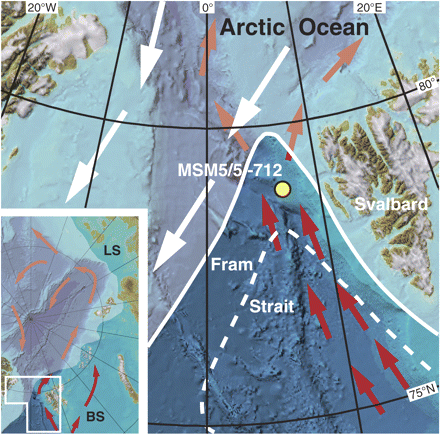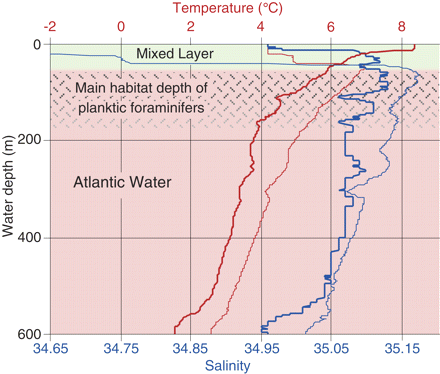博文
[1-28-Science最新文章]大西洋暖流加速了向北极地区的热传输作用
|||
大西洋暖流加速了向北极地区的热传输作用
Enhanced Modern Heat Transfer to the Arctic by Warm Atlantic Water
原文citation:Spielhagen, R. F., K. Werner, et al. "Enhanced Modern Heat Transfer to the Arctic by Warm Atlantic Water." Science 331(6016): 450-453.
不断升高的温度(1-3)和海冰面的下降(4,5)证明北极地区正加速变暖,这与长期变冷的趋势刚好相反(6)。北大西洋洋流弗拉姆海峡分支(Fram Strait Branch, FSB,下文同)中相对较暖的大西洋水流(Atlantic Water , AW)正是将大洋热量输送到北极地区的主要载体(Fig.1)。它维持着现今东弗拉姆海峡的永久不封冻环境,并且为北冰洋中低层海水提供盐分,因此而稳固了分层作用(stratification)(7,8)。在东弗拉姆海峡地区,具有2-6ºC温度、>35.0盐度的大西洋水流(下文用AW代替)在50-600m水深位置已经被发现(Fig.2)。一年中的大部分时间里它都被一低盐度的、温度季节性变化的混合层以及极冬冰盖所覆盖。这些因素在过去的2000年里也不断变化着,正如如海冰观测和沉积物结核研究结果所表明的一样(5,9)。

Fig. 1 Bathymetric map of the Fram Strait area and the eastern Arctic Ocean (inset; source: www.ibcao.org). Average sea ice coverage for April [1989 to 1995; stippled line: 1963 to 1969 (31)] and September (inset; 1979 to 2000; source: http://nsidc.org) is indicated by white shading. White arrows indicate ice flow direction in Fram Strait area. Red arrows indicate flow direction of Atlantic Water. Atlantic water flow is below halocline waters in the Arctic Ocean proper. Yellow spot marks station MSM5/5-712 at 78°54.94'N, 6°46.04'E, 1491-m water depth. BS, Barents Sea; LS, Laptev Sea.

Fig. 2 Water-mass structure of the upper 600 m at station MSM5/5-712. Seasonal variability of temperature (red lines) and salinity (blue lines) in the Atlantic Water (pink) is revealed by our measurements in summer (4 August 2007; bold lines) and early winter (11 October 2006; thin lines). The main habitat of planktic foraminifers in the eastern Fram Strait (16, 18) is marked by a dashed pattern.
晚第四纪时期向北极地区的各种AW对流活动已经由多种媒介(proxies)所记录下来,如微体化石的丰度、流量和沉积物结核中的物种比例(副极地种类/极地种类,subpolar versus polar species)。对流高峰主要是处于相对较暖的时期(间冰期和间冰段,interglacials and interstadials)(10-12)。全新世(过去12千年,ky)在10-9千年期间有一个热高峰时期(thermal maximum),紧随其后的是一个较冷的时期(13)。但是,先前的研究并未能很好地解析几千年来甚至更短时期内的变化。这些变化可以通过研究欧洲气候的历史数据和媒介数据而得到很好地认识(14),并相应地将过去的两千年再细分为罗马热期(Roman Warm Period, RWP, 直到~公元600年)、黑暗时代寒期(Dark Ages Cold Period, DACP, 公元~600-900年)、中世纪气候异常期(Medieval Climate Anomaly, MCA, 公元~900-1500年)、小冰期(Little Ice Age, LIA, 公元~1500-1900年)以及现代(工业)时期(Modern/Industrial Period)。这些时期之间的分界时间可能随地区不同而变化。
为了重建过去~2000年以来FSB中AW的温度变化过程,我们对一沉积结核中的浮游有孔虫进行了研究,这些样品是2007年8月在西斯瓦尔巴(Svalbard)陆缘MSM5/5-712点位采集的(Fig.1)。该位置正好处于AW流入北冰洋的路径上。样品MSM5/5-712-1(表S1)中放射性碳元素测年显示公元前120年-公元1475年期间沉积速率为18-20cm/ky,随后是27.7cm/ky,分辨率为每0.5cm对应28年和18年(Fig.3)。沉积结核顶部属现代时期。底栖生物的扰动作用可能与某些古环境标志有关,但是要量化这些作用是很困难的。我们对流入北冰洋的AW的温度重建研究基于以下两种独立的方法:(i)SIMMAX现代模拟技术(15),该方法可以利用浮游有孔虫种类统计来计算50m水深处的温度;(ii)Neogloboquadrina pachyderma (sinistral)的Mg/Ca值。具体的方法细节见参考材料。东弗拉姆海峡浮游有孔虫的栖息和钙化深度为水下50m直到~300m,但是主要分布在150m深以上(16)。在这一地区,浮游生物的爆发通常出现在8月(16)。因此,我们的温度重建反应的是近几十年来AW层顶部的仲夏环境。

Fig. 3 Planktic foraminiferal data and temperature reconstructions of upper Atlantic Water in the eastern Fram Strait over the past ~2100 years from sediment core MSM5/5-712-1. Thin lines are raw data, bold lines are three-point running means. Black triangles on the age scale mark calibrated accelerator mass spectrometry 14C ages. (A) Fluxes of polar and subpolar planktic foraminifers (100- to 250-μm fraction). (B) Percentage of subpolar planktic foraminifers in the 100- to 250-μm fraction. (C) Summer temperatures at 50-m water depth (red) calculated by the SIMMAX Modern Analog Technique. Gray bars mark averages until 1835 CE and 1890 to 2007 CE. Blue line is the normalized Atlantic Water core temperature (AWCT) record (standard deviations) from the Arctic Ocean (1895 to 2002; 6-year averages) obtained from (21). (D) Summer temperatures (purple) calculated from Mg/Ca ratios in planktic foraminifers N. pachyderma (sinistral). Gray bars mark averages until 1835 CE and 1890 to 2007 CE. Blue line is the sea ice margin anomaly (11-year means, less ice is up) in the Barents Sea (BS) obtained from (5). Dashed lines mark less reliable data before 1850 CE. (E) Terrestrial Arctic [green, from (6)] and Northern Hemisphere [black, 25-year means, from (19)] temperature anomaly records with reference to the 980 to 1800 CE and 1961 to 1990 CE averages, respectively.
浮游有孔虫组织对于最北部北大西洋水体分布和海洋锋(oceanic fronts)具有极好的指示作用(17)。MSM5/5-712-1样品中浮游有孔虫数据显示了高频(多期,multidecadal)变化条件下多个世纪的变化情况(multicentennial changes)(Fig.3A;物种分布详见fig.S1)。RWP,MCA-LIA过渡期和现代时期以副极地和极地物种的高流量为特点,而DACP和LIA晚期则是低流量记录(Fig.3)。流量变化似乎是对海冰面的反应,因为现在发现弗拉姆海峡海冰覆盖区浮游有孔虫流量最低而海冰边缘地区则流量最高(18)。公元~1900年以前的样品沉积物中,全部浮游有孔虫中有10-40%属于副极地物种。相反地是,反应近~100年来情况的最年轻的沉积物表明,副极地有孔虫流量在快速增长,副极地-极地物种比例也出现了史无前例的倒转,在地表样品中达到了66%副极地物种比例(Fig.3B)。因为副极地物种的比例与水体分布密切相关,该比例在北极海水中低而在AW中高(16-18),现代时期样品中含有最高的副极地有孔虫流量和比例,预示着从挪威海输出的较暖的AW具有不断增强的影响作用。
根据SIMMAX和Mg/Ca测量结果,我们可以定量分析温度的升高情况,同时也结合考虑现代时期西斯瓦尔巴地区AW的强烈影响作用。直到公元~1850年,根据SIMMAX模拟结果,平均夏季温度变化于2.8-4.4ºC(平均±SE:3.4º±0.06ºC),在寒冷时期(如早DACP,LIA)具有较低值,而在早MCA公元800-1100年间具有最高值(Fig.3C)。该结果与北半球及环北极地区温度变化的陆地记录(6,19)非常相似(Fig.3E)。自1890年以来AW温度为4.1-6.0ºC(平均±SE:5.2º±0.22ºC),因此比早前的2ky高~2ºC。通过地表样品计算,温度急速增长到史无前例的6ºC的过程,这明显从1850年就已经开始了。然后,这一逐渐的过渡却可能是由LIA后期有孔虫较为缺乏的沉积物和现代时期有孔虫较为富集的沉积物由于生物扰动而混合形成的假象。根据Mg/Ca测量值得出的温度重建结果与SIMMAX的结果非常相似(Fig.3D)。现代时期以前的变化很大(0.7-5.7ºC),其原因可能是由于Mg/Ca方法不能准确重现3ºC以下的温度造成的(20; 见参考材料讨论),但是3.6ºC(±0.3ºC,SE)的温度平均值证实了SIMMAX的结果。同样地也适用于现代时期:根据Mg/Ca数据计算结果,自1890年以来温度变化于4.4-7.1ºC,平均值为5.8ºC(±0.5ºC,SE)。两种方法中,现代时期的温度平均值均超过了先前两千年中的所有个别值。这些结果显示,在过去的~120年里北极地区FSB中最上部AW温度快速变暖达~2ºC,与巴伦支海海冰面的后退(5)、陆地古气候参考记录(6,19)(Fig.3, C-E)以及大气观测(3)研究结果较为一致。值得注意地是,现在东弗拉姆海峡最上部AW的夏季温度比MCA时期平均温度最大值(根据生物扰动作用和采样平均)还高1.5ºC以上。
自LIA时期以来~2ºC的变暖结果,与根据过去~120年观测数据所获得的AAWL(Arctic Atlantic Water Layer)的温度升高是一致的(Fig.3C)。目前为止,还没有亚世纪尺度的公开海洋媒介数据来研究过去的两千年里北冰洋中AAWL的温度演化过程。更进一步,在东挪威海,根据硅藻类(22)和浮游有孔虫的稳定同位素(23)研究得到的夏季海洋表层温度(SSST)变化高精确度记录显示,西挪威海自LIA时期以来有~1.5ºC的变暖。但是上世纪90年代后期东挪威海SSSTs并没有明显MCA时期周期性的变化(22,23)。相对于过去的2000年时间里(包括罗马时期和中世纪里的温暖期),东弗拉姆海峡变暖的现代AW温度,反应了全球变暖在北极地区扩大(1,24)的一面。最近的模拟结果(25,26)表明了海冰的重要作用,以及作为一个可能的放大器的巴伦支海地区的大气压强的作用,至少在一定程度上可能与异常变暖的AW对流有关。
20世纪北极地区的工业气体和AW温度及其他,显示了准同步多期波动变化,使得远离工业化变暖趋势十分困难(3,21)。自上世纪80年代以来,海盆观测检测到多年来北冰洋地区AW扩张,以明显的变暖和对北冰洋流入量增长为特点(7,27,28)。尽管我们目前还不能根据我们的数据去定量分析先前流入北极地区的体积的变化,但我们的温度数据和以上所观测到的联系表明,现代AW暖流活动(平均20-30年)在过去的2000年里是异常的也是独特的,而不仅仅是一系列自然多期波动的最后一幕。两种作用——温度升高以及体积运输增长,导致对北冰洋大量的热输入。尽管AAWL没有与北极地区大洋表层直接接触,但增长的热输入将会造成深远的后果。上世纪90年代北冰洋强烈的AW热事件导致AW结核变浅以及对表层的热流量增强(29),同时伴随着海冰量的减少(4)。最近来自拉普捷夫海(Laptev Sea)陆缘的海洋学数据显示了较暖的AW相关的水体对浅部大陆架的影响作用(30),这一特征并未在过去的80年时间里观测到。这些数据同样证实了流向上覆大陆架海水的显著热流(30)。即使对垂向热传输过程不做任何调整,AW和表层海水冰点之间的巨大温差,将会引起垂向上大约40%的热流。任何正反馈机制都将会扩大冰盖上的这种热增长作用。填补冰和大气层之间强烈反馈(1)以及AW层的不断变暖,这些在过去的2000年里是全所未有的,而这可能是面向未来无冰北冰洋的过渡时期的关键要素。
Supporting Online Material
www.sciencemag.org/cgi/content/full/331/6016/450/DC1
References and Notes
- J. A. Screen, I. Simmonds, The central role of diminishing sea ice in recent Arctic temperature amplification. Nature 464, 1334 (2010). doi:10.1038/nature09051 pmid:20428168 CrossRefMedlineWeb of Science
- R. G. Graversen, T. Mauritsen, M. Tjernström, E. Källén, G. Svensson, Vertical structure of recent Arctic warming. Nature 451, 53 (2008). doi:10.1038/nature06502 pmid:18172495 CrossRefMedlineWeb of Science
- P. Chylek, C. K. Folland, G. Lesins, M. K. Dubey, M. Muyin Wang, Arctic air temperature change amplification and the Atlantic Multidecadal Oscillation. Geophys. Res. Lett. 36, L14801 (2009). doi:10.1029/2009GL038777 CrossRef
- J. C. Comiso, C. L. Parkinson, R. Gersten, L. Stock, Accelerated decline in the Arctic sea ice cover. Geophys. Res. Lett. 35, L01703 (2008). doi:10.1029/2007GL031972 CrossRef
- D. V. Divine, C. Dick, Historical variability of sea ice edge position in the Nordic Seas. J. Geophys. Res. 111, C01001 (2006). doi:10.1029/2004JC002851CrossRef
- D. S. Kaufman et al., Recent warming reverses long-term arctic cooling. Science 325, 1236 (2009). doi:10.1126/science.1173983 pmid:19729653 Abstract/FREE Full Text
- B. Rudels, E. P. Jones, L. G. Anderson, G. Kattner, in The Polar Oceans and Their Role in Shaping the Global Environment, O. M. Johannessen, R. D. Muench, J. E. Overland, Eds. (American Geophysical Union, Washington, DC, 1994), pp. 33–46.
- U. Schauer, E. Fahrbach, S. Osterhus, G. Rohardt, Arctic warming through the Fram Strait: Oceanic heat transport from 3 years of measurements. J. Geophys. Res. 109, C06026 (2004). doi:10.1029/2003JC001823 CrossRef
- S. Bonnet, A. de Vernal, C. Hillaire-Marcel, T. Radi, K. Husum, Variability of sea-surface temperature and sea-ice cover in the Fram Strait over the last two millennia. Mar. Micropaleontol. 74, 59 (2010). doi:10.1016/j.marmicro.2009.12.001 CrossRef
- D. Hebbeln, T. Dokken, E. S. Andersen, M. Hald, A. Elverhøi, Moisture supply for northern ice-sheet growth during the Last Glacial Maximum. Nature 370, 357 (1994). doi:10.1038/370357a0 CrossRef
- T. M. Dokken, M. Hald, Rapid climatic shifts during isotope stages 2–4 in the Polar North Atlantic. Geology 24, 599 (1996). doi:10.1130/0091-7613(1996)024<0599:RCSDIS>2.3.CO;2Abstract/FREE Full Text
- R. F. Spielhagen et al., Arctic Ocean deep-sea record of northern Eurasian ice sheet history. Quat. Sci. Rev. 23, 1455 (2004). doi:10.1016/j.quascirev.2003.12.015 CrossRefWeb of Science
- M. Hald et al., Variations in temperature and extent of Atlantic Water in the northern North Atlantic during the Holocene. Quat. Sci. Rev. 26, 3423 (2007). doi:10.1016/j.quascirev.2007.10.005 CrossRefWeb of Science
- H. H. Lamb, Climate: Present, Past and Future (Methuen, London, 1977).
- U. Pflaumann, J. Duprat, C. Pujol, L. D. Labeyrie, SIMMAX: A modern analog technique to deduce Atlantic sea surface temperatures from planktonic foraminifera in deep-sea sediments. Paleoceanography 11, 15 (1996). doi:10.1029/95PA01743 CrossRefWeb of Science
- R. Volkmann, Planktic foraminifers in the outer Laptev Sea and the Fram Strait: Modern distribution and ecology. J. Foraminiferal Res. 30, 157 (2000). doi:10.2113/0300157 Abstract/FREE Full Text
- T. Johannessen, E. Jansen, A. Flatøy, A. C. Ravelo, in Carbon Cycling in the Glacial Ocean: Constraints on the Ocean’s Role in Global Change, R. Zahn, T. F. Pedersen, M. A. Kaminski, L. Labeyrie, Eds. (Springer-Verlag, Berlin, 1994), pp. 61–85.
- J. Carstens, D. Hebbeln, G. Wefer, Distribution of planktic foraminifera at the ice margin in the Arctic (Fram Strait). Mar. Micropaleontol. 29, 257 (1997). doi:10.1016/S0377-8398(96)00014-X CrossRefWeb of Science
- A. Moberg, D. M. Sonechkin, K. Holmgren, N. M. Datsenko, W. Karlén, Highly variable Northern Hemisphere temperatures reconstructed from low- and high-resolution proxy data. Nature 433, 613 (2005). doi:10.1038/nature03265 pmid:15703742 CrossRef
- R. Kozdon, A. Eisenhauer, M. Weinelt, M. Y. Meland, D. Nürnberg, Reassessing Mg/Ca temperature calibrations of Neogloboquadrina pachyderma (sinistral) using paired δ44/40Ca and Mg/Ca measurements. Geochem. Geophys. Geosyst. 10, Q03005 (2009). doi:10.1029/2008GC002169 CrossRef
- I. V. Polyakov et al., Variability of the intermediate Atlantic water of the Arctic Ocean over the last 100 years. J. Clim. 17, 4485 (2004). doi:10.1175/JCLI-3224.1 CrossRef
- N. Koç, E. Jansen, in Climate Development and History of the North Atlantic Realm, G. Wefer, W. H. Berger, K.-E. Behre, E. Jansen, Eds. (Springer-Verlag, Berlin 2002), pp. 165–173.
- D. Klitgaard Kristensen, H. P. Sejrup, H. Haflidason, I. M. Berstad, G. Mikalsen, Eight-hundred-year temperature variability from the Norwegian continental margin and the North Atlantic thermohaline circulation. Paleoceanography 19, PA2007 (2004). doi:10.1029/2003PA000960 CrossRef
- M. Serreze, J. A. Francis, The Arctic Amplification debate. Clim. Change 76, 241 (2006). doi:10.1007/s10584-005-9017-y CrossRef
- H. Goosse, M. M. Holland, Mechanisms of decadal Arctic climate variability in the Community Climate System Model, Version 2 (CCSM2). J. Clim. 18, 3552 (2005). doi:10.1175/JCLI3476.1 CrossRef
- V. A. Semenov, W. Park, M. Latif, Barents Sea inflow shutdown: A new mechanism for rapid climate changes. Geophys. Res. Lett. 36, L14709 (2009). doi:10.1029/2009GL038911 CrossRef
- M. J. Karcher, R. Gerdes, F. Kauker, C. Köberle, Arctic warming: Evolution and spreading of the 1990s warm event in the Nordic seas and the Arctic Ocean. J. Geophys. Res. 108, 3034 (2003). doi:10.1029/2001JC001265 CrossRef
- I. A. Dmitrenko et al., Toward a warmer Arctic Ocean: Spreading of the early 21st century Atlantic Water warm anomaly along the Eurasian Basin margins. J. Geophys. Res. 113, C05023 (2008). doi:10.1029/2007JC004158 CrossRef
- M. Steele, T. Boyd, Retreat of the cold halocline layer in the Arctic Ocean. J. Geophys. Res. 103, 10419 (1998). doi:10.1029/98JC00580 CrossRef
- I. A. Dmitrenko et al., Impact of the Arctic Ocean Atlantic water layer on Siberian shelf hydrography. J. Geophys. Res. 115, C08010 (2010). doi:10.1029/2009JC006020 CrossRef
- R. R. Dickson et al., The Arctic Ocean Response to the North Atlantic Oscillation. J. Clim. 13, 2671 (2000). doi:10.1175/1520-0442(2000)013<2671:TAORTT>2.0.CO;2CrossRef
We thank the captains, crews, and shipboard scientific parties of research vessels Jan Mayen and Maria S. Merian for assistance during cruises JM06-WP and MSM5/5. R.F.S. and K.W. acknowledge support from the German Research Foundation (Deutsche Forschungsgemeinschaft Priority Core Program 1266 INTERDYNAMIK, project HOVAG); R.F.S. received support from the Academy of Sciences, Humanities, and Literature, Mainz; and S.A.S., K.Z., K.H., and M.H. acknowledge support from the Norwegian Research Council (projects SciencePub and WARMPAST). All data are available at www.pangaea.de (doi:10.1594/PANGAEA.755114).
https://blog.sciencenet.cn/blog-92454-408716.html
上一篇:地球内部的基本结构和物质组成
下一篇:发现SiO2新高压相:对“超级地球”内部物质构造的启示